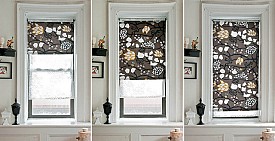Will Blackout Curtains Keep You Cooler This Summer?
 Seems like just yesterday we were groaning over our high heating bills. Now with the full heat of summer about to hit, we're looking for ways to keep ourselves cooler and make our A/C use more efficient.
Seems like just yesterday we were groaning over our high heating bills. Now with the full heat of summer about to hit, we're looking for ways to keep ourselves cooler and make our A/C use more efficient.
Hanging blackout curtains is one of the cheapest, easiest solutions imaginable. Blackout curtains are also known as "thermal drapes" for a reason. They're ideal for blocking light and heat from windows that get strong sun. And the best part is that contrary to popular belief, blackout curtains do not have to be black. They don't even have to be curtains!
Find out more.
Types of Blackout Coverage
Simple though rather stark, roll-down blackout shades will keep out sunshine if they are properly fitted to cover the whole window. You may be able to have them custom cut to your specs.
Blackout liners may be used with your existing window treatments. Not only will they shut out the warmth of the sun, they'll also protect your curtains from fading.
If you're going for the real deal, you can purchase blackout curtains readymade in various lengths. However, DIY and frugal types take note: curtains are one of the easiest sewing projects imaginable. Tailoring them yourself will let you get the precise dimensions and the look you like.
Blackout fabric is available as woven or knit in a wide variety of prints and solid colors. The material, which drapes well, is not especially dark in appearance, but it's lined with lightweight foam or contains a "core" of black sunblock fiber. Whether premade or home-crafted, your blackout curtains will be washable (double-check care instructions first!). For extra-easy care, hang them back up while still wet so they won't wrinkle. You'll also save electricity by not putting them in the dryer.
How to Use Them
Hang curtains to completely screen any sunny window; they can easily be opened to admit air at cooler times. If the curtains come with a white liner, position that facing the glass to deflect sun from your room. This will make your homeowners' association happy as well -- many stipulate only white window treatments should be visible from the street. (In fact, hanging thermal curtains outside would be the best way to reduce heat transfer, though HOAs and neighbors might not be enthusiastic about the look.)
Be sure to close blackout drapes or blinds well before the sun starts streaming in; don't wait till the room has already heated up. East-facing windows should be covered first thing in the morning, to avoid the dawn's early light, and west-facing before the full afternoon glare. You can spread them at less sunny times and open the windows while you're at it, if the outdoor air has cooled down appreciably. This will help ventilate the room.
Renters will be glad to know that blackout curtains are cheap and easy to reuse when you move. Cut-to-measure shades are portable too, but there's no guarantee they will be the right size for your new windows, and a less-than-perfect fit tends to defeat the purpose by allowing light in.
How They Help
Blackout curtains and shades will reduce the amount of heat which is transferred via your windows by as much as 24 percent, keeping the rooms where they're installed cooler in summer and warmer in winter. This will allow you to use your heating and cooling system more efficiently and save energy.
As a fringe benefit, your sleep won't be disturbed by melatonin-inhibiting bright light -- great news for insomniacs and night shift workers. The thermal curtains even help to muffle exterior noise.
For more energy-efficient heating and cooling solutions, contact a reliable HVAC contractor.
Laura Firszt writes for networx.com.
Updated December 30, 2018.
Looking for a Pro? Call us (866) 441-6648

Heating & cooling Average Costs
HVAC Contractors Experiences

I Built A Concrete Retaining Wall As A Defense Against El Nino

Lawn Repair: Contractor Followup To My DIY Prep Got The Job Done



